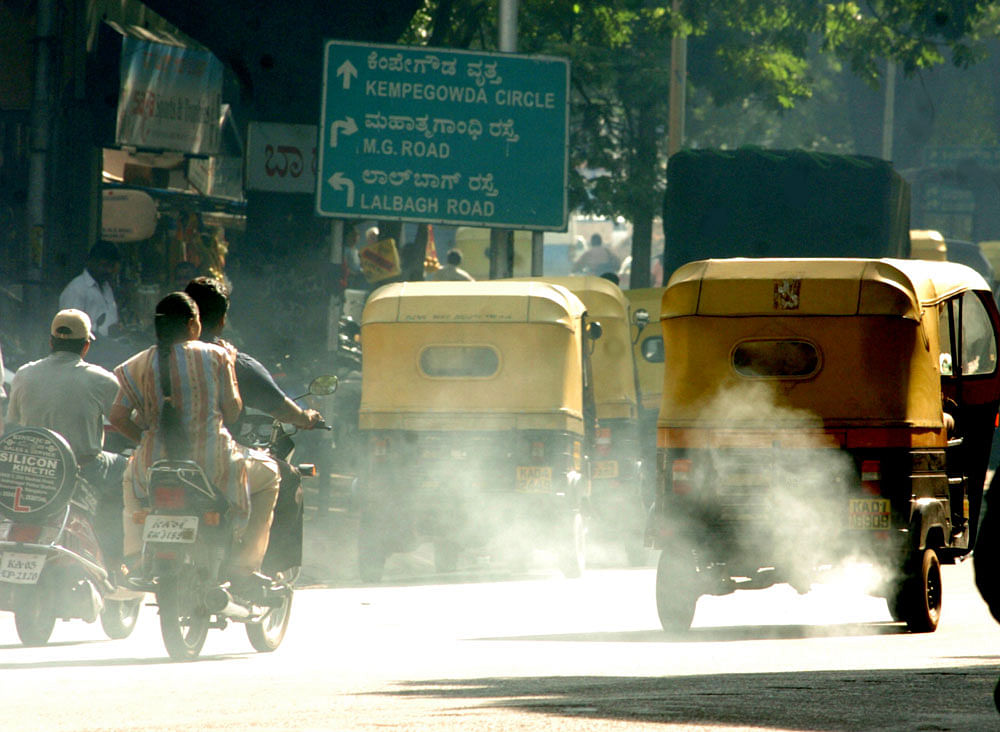City's rising pollution contributing to heart attacks, say doctors
Last Updated IST

The prevalence of heart attacks among drivers has led the institute to pursue a study that will involve 500 autorickshaw drivers and traffic policemen. DH File Photo
Air pollution is a significant contributor to increasing cases of heart attack in the city.
According to Dr C N Manjunath, director and head of cardiology, Sri Jayadeva Institute of Cardiovascular Sciences and Research, around 20% of the heart attack cases admitted to the ICU at the institute are caused due to air pollution. “Most of the patients with heart attacks caused due to air pollution are drivers,” he added.
The prevalence of heart attacks among drivers has led the institute to pursue a study that will involve 500 autorickshaw drivers and traffic policemen.
He added that certain particulate matter present in the patients’ blood vessels could damage them.
“Toxic gases such as sulphur dioxide, carbon monoxide, nitrogen dioxide, lead, ozone among others are present in the air. This is mainly due to vehicle exhaust,” said Dr Adil Sadiq, head of cardiothoracic surgery and senior consultant cardiothoracic and vascular surgeon, Sakra World Hospital.
Dr Bhagirath Raghuraman, senior consultant, interventional cardiologist and heart transplant physician, Narayana Institute of Cardiac Sciences, Narayana Health City, said the quantity and duration of air inhaled should be taken into consideration. Drivers and those living near industrial areas are the most affected, he said.
“People with established heart blockages should avoid air pollution since even a low amount of particulate matter may worsen their heart condition,” he added.
Dr Sadiq said air pollution also causes hypertension and stroke (paralysis). Around 95% of regular masks do not filter particulate matter which is less than 10 mc (micrograms per cubic metre) or 25 mc.
According to doctors, the particulate matter enters the body and starts accumulating over a period of time which causes blockages or inflammation in the blood vessels. They also said the number of vehicles in Bengaluru is increasing.
All 15 stations monitoring the ambient air quality index of Bengaluru indicated moderate levels of air pollution in April 2016. Such levels, according to Karnataka State Pollution Control Board (KSPCB), are enough to cause breathing discomfort to people with lung and heart diseases in both children and adults. The index also indicated moderate levels of air pollution in 10 of the 15 stations in the beginning of the year.
The latest indications in March 2017 showed six stations with moderate levels. The moderate level of air pollution at Central Silk Board, Hosur Road, Graphite India Ltd, Whitefield Road, KHB Industrial Area, Yelahanka, Swan Silk Pvt Ltd, Peenya, Urban Eco Park, Peenya, Teri Office and Old Airport Road has been stagnant since the beginning of the year.
“Smooth vehicular movement helps reduce vehicle pollution and therefore we are trying to propose long-term solutions like building flyovers among others to reduce pollution,” said a senior KSPCB official.
According to Dr C N Manjunath, director and head of cardiology, Sri Jayadeva Institute of Cardiovascular Sciences and Research, around 20% of the heart attack cases admitted to the ICU at the institute are caused due to air pollution. “Most of the patients with heart attacks caused due to air pollution are drivers,” he added.
The prevalence of heart attacks among drivers has led the institute to pursue a study that will involve 500 autorickshaw drivers and traffic policemen.
He added that certain particulate matter present in the patients’ blood vessels could damage them.
“Toxic gases such as sulphur dioxide, carbon monoxide, nitrogen dioxide, lead, ozone among others are present in the air. This is mainly due to vehicle exhaust,” said Dr Adil Sadiq, head of cardiothoracic surgery and senior consultant cardiothoracic and vascular surgeon, Sakra World Hospital.
Dr Bhagirath Raghuraman, senior consultant, interventional cardiologist and heart transplant physician, Narayana Institute of Cardiac Sciences, Narayana Health City, said the quantity and duration of air inhaled should be taken into consideration. Drivers and those living near industrial areas are the most affected, he said.
“People with established heart blockages should avoid air pollution since even a low amount of particulate matter may worsen their heart condition,” he added.
Dr Sadiq said air pollution also causes hypertension and stroke (paralysis). Around 95% of regular masks do not filter particulate matter which is less than 10 mc (micrograms per cubic metre) or 25 mc.
According to doctors, the particulate matter enters the body and starts accumulating over a period of time which causes blockages or inflammation in the blood vessels. They also said the number of vehicles in Bengaluru is increasing.
All 15 stations monitoring the ambient air quality index of Bengaluru indicated moderate levels of air pollution in April 2016. Such levels, according to Karnataka State Pollution Control Board (KSPCB), are enough to cause breathing discomfort to people with lung and heart diseases in both children and adults. The index also indicated moderate levels of air pollution in 10 of the 15 stations in the beginning of the year.
The latest indications in March 2017 showed six stations with moderate levels. The moderate level of air pollution at Central Silk Board, Hosur Road, Graphite India Ltd, Whitefield Road, KHB Industrial Area, Yelahanka, Swan Silk Pvt Ltd, Peenya, Urban Eco Park, Peenya, Teri Office and Old Airport Road has been stagnant since the beginning of the year.
“Smooth vehicular movement helps reduce vehicle pollution and therefore we are trying to propose long-term solutions like building flyovers among others to reduce pollution,” said a senior KSPCB official.